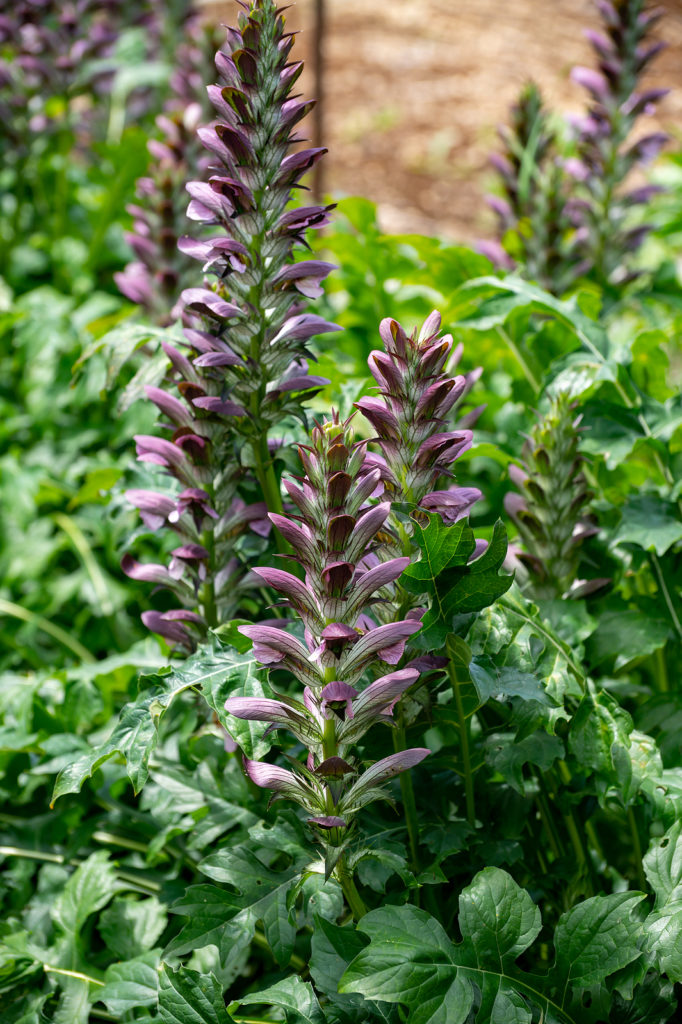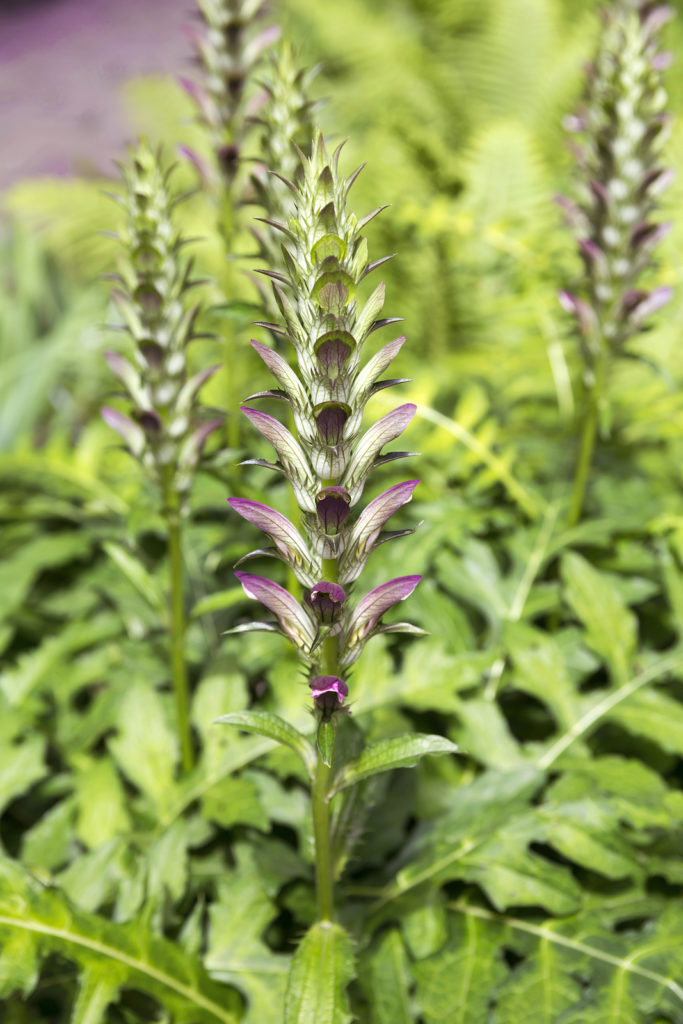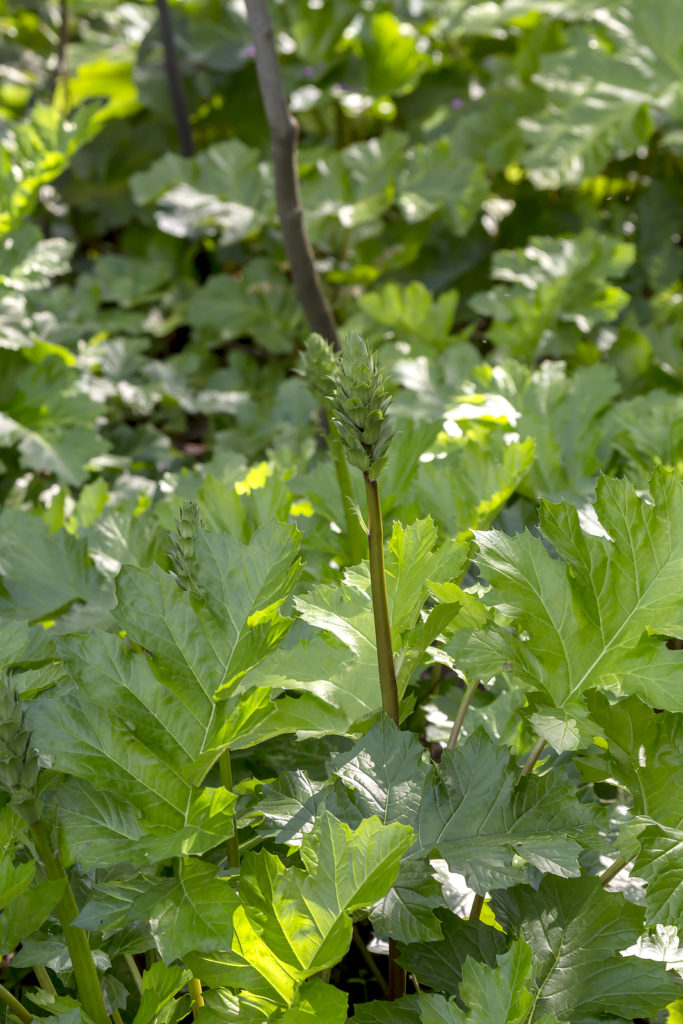Acanthus–commonly called bear’s breeches–is an imposing perennial with deeply cut, glossy dark green leaves, and tall snapdragon-like flowers. It is grown for its bold-textured evergreen leaves and sculptural beauty. The mauve-and-white tubular flowers bloom on tall, dramatic stalks for a month in early summer. The flowers can be freshly cut.
Acanthus can be used in large borders where it is allowed to spread. It is dramatic in the midground, surrounded by beds and borders where the foliage can be admired but the tall flower stalks won’t block other plants.
The 2-foot-long evergreen leaves are lustrous green and deeply divided. The stalks have lethal-looking white spines along the edges. These spines are actually not sharp, but spines around the bracts that surround the flowers can be vicious.
Acanthus comes from the Mediterranean and is heat-loving. It is semi-hardy; it does best in rich, well-drained soil and full sunlight. Although semi-hardy, Acanthus needs heavy winter protection in cold winter regions
Acanthus is especially useful for background plantings.
Propagation by division of the roots may be done in spring or early autumn.

Get to know Acanthus
- Plant type: Perennial, somewhat tender
- Growing zones and range: Zones 6 to 10; best where summers are hot and dry, but tolerates humidity.
- Hardiness: Hardy to 0°F (-18°C); can not survive in frozen ground; heat tolerant.
- Height and width: 3 to 4 feet (1-1.2m) tall; 2 to 3 feet (.6-1m) wide
- Foliage: Coarsely toothed, shiny green semideciduous leaves measuring 24 inches (61cm) long
- Flower form and color: Two-lipped tubular flowers on gorgeous spikes are mauve and white; spikes to 18 inches (45cm) long
- Bloom time: Late spring to early summer
- Common name: Spiny bear’s breeches
- Botanical name: Acanthus mollis and A. spinosus
- Family: Acanthaceae
- Origin: Mediterranean region to Asia
Where to plant Acanthus
- Plant acanthus in full sun to light shades; in hot summer regions, acanthus is best planted in partial shade.
- Acanthus grows best in moist but well-drained average to sandy soil.
- Plant acanthus where the roots will not be overly wet. Acanthus is drought tolerant.
- Soil pH: 7 or nearly neutral.
Acanthus uses and companions
- Grow Acanthus in a spacious border.
- Use Acanthus in midground where foliage clumps can be admired but tall flower stalks will not block other plants.
- Flowers are good for cutting and drying.
- Companions include Anemone hybrida, Liriope, and Polygonatum.

When to plant Acanthus
- Acanthus takes several years to flower if it’s started from seed. Plant seeds ¼ inch deep. Start seeds 8 to 10 weeks before the last frost.
- Set out seedlings in spring or fall and keep them well watered for the first few months.
- Sow seed outdoors in early spring when the weather has warmed. It’s best to start seedlings in pots and grow them on for two years before transplanting to the garden.
Planting and spacing Acanthus
- Space acanthus 3 to 4 feet apart.
- Deeply dig planting bed and add aged compost or planting mix before planting. Improve drainage by adding sand to the planting bed.
How to water and feed Acanthus
- Feed acanthus lightly if at all.
Acanthus care
- Divide plants in spring.
- Handle mature plants with leather gloves; parts of the plant are sharp.
- Cut back spent flower spikes after flowering.
- In cold regions, cover the crowns with straw for protection through winter.
Acanthus problems
- Slugs and snails can be a problem. Dust the ground with lime and ashes or diatomaceous early or set out slug traps.
- Acanthus is rabbit resistant.
- Tough roots can make the plant difficult to remove.

Acanthus propagation
- Plant container-grown plants any time of the year.
- Divide mature plants in late winter or early spring when new growth begins; keep well watered until established.
- Thick roots can be used as root cuttings. Place cuttings in pots in the cold frame in winter.
- Acanthus can be propagated by seed. Sow seeds in containers in a cold frame in spring.
Acanthus Varieties to Grow
- Acanthus hungaricus: Species similar to A. spinosus but with paler foliage; slow-spreading; hardiest for northern regions.
- A. mollis, bear’s breeches: Mostly evergreen grow to 5 feet tall; best garden type; cultivars include ‘Oak Leaf’ which is similar to the species, and ‘Latifolius’ which has larger leaves than the species and is hardier.
- A. spinosa: Perennial with small finely cut leaves covered by sharp spines.















